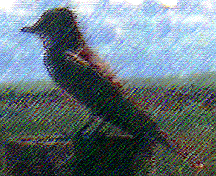|
|
|
Journal of a Sabbatical
| |||||||||
|
| |||||||||||
|
September 10, 1998 |
|
whimbrels in the wind | |||||||||
|
|
|
| |||||||||
|
Birds: 2 semipalmated plovers Other: 1 monarch butterfly
Copyright © 1998, Janet I. Egan |
|
It was such a beautiful day that I spontaneously decided to go to Nelson Island instead of coming home and working after I had my coffee. On the dirt road onto the island, I pulled over and watched three guys pruning the trees. They wore orange hard hats with black face masks that made them look like aliens. One guy would go up in the cherry picker and cut off the offending branch with his saw and the two other guys would drag it into the road and around behind the truck where they'd feed it into the wood chipper. Nancy called me on the car phone while I was watching this, so I chatted with her until the road was passable again. When I got to the parking lot at the refuge boundary, there were other cars there. Not something I encountered on my last trip. A guy got out of the car parked next to mine and put on his waders, then shouldered his rifle and started walking out onto the causeway. Uh-oh! It's hunting season! Not only that, it's high tide. I got a few yards onto the causeway before it became impassable without boots. Two semipalmated plovers waded in a puddle oblivious to me. A flock of about a hundred tree swallows swooped down over the marsh. The young man with the gun walked by and said hello. I mumbled something about how he was smart to wear boots. He looked at me and responded:"Well, it is pretty near high tide." I walked back to the car and headed for Plum Island and the main part of the refuge. I walked the Marsh Loop trail taking pictures of purple asters, ripe berries of various kinds, leaves tuning red (poison ivy and Virginia creeper), and fungus growing on bark. I had the marsh all to myself. There were a few other vehicles parked at the Hellcat parking lot but the associated people were all up by the beaver dam looking for the fork tailed flycatcher. I turned a corner on the trail and startled 3 cedar waxwings feasting on berries. Gorging on berries is more like it. They settle down again in about 30 seconds, really close to me. I could easily identify them without binoculars and get a good look at what they were eating (alas I didn't have my field guide to berries with me). One time a few weeks ago I was talking with a guy who was trying to photograph the fork tailed flycatcher. He was trying to tell me a story about photographing cedar waxwings but he couldn't think of the name. He said: "You know, the ones that come in the fall to eat berries and don't stay very long." I knew exactly what he meant. I thought of that as i watched them at their feast. It's like for a few days in September their entire reason for being is to eat berries. Back up on the dike, I watched a few green winged teal dabbling. As my eyes followed them closer to shore, I picked up something moving in the grass. Not a bird. A raccoon ambled ever so slowly along the edge of the water toward a juvenile black crowned night heron. The heron took off and landed a few yards away. While I was watching all this, three guys who had been keeping vigil for the fork tailed flycatcher had moved to the fence on the south end of the dike and were looking intently through scopes at something on the dike. I strolled over to see what was up. A whole flock of whimbrels was pecking around in the grass with their graceful decurved beaks on the side of the dike. I thought that was pretty cool because it was the closest I've ever been to a whimbrel. Usually they are so far away I'm straining to make the identification. These were so close I knew what they were before I whipped the binoculars out. That's not what the boys were looking at though. They were looking at a group of black bellied plovers, also really close. It took me awhile to realize that not all the black bellied plovers were black bellied plovers. At least two of them were different. Two of the boys discussed the fine points of identification. I looked in my book and guessed. The third boy had his binoculars but not his book so I let him look at mine. We all finally came to consensus on golden plover. None of the three boys had seen the forktailed flycatcher yet and they did not know it was a juvenile. I told them where to look and started walking to my car. Suddenly, the forktailed flycatcher flew right past my head and landed on a bare shrub just to my left, on the edge of the pool. I gestured wildly to the boys over by the fence, pointing exaggeratedly at the forktailed flycatcher. Finally the book less one noticed me and came running over. I gave him the two bit speech about how it had a shorter tail and a brown rather than yellow cap and didn't look like the one in the book but matched the description of an immature. The other two boys finally made it over and trained their scopes on it. The book less boy thanked me for finding it. | |||||||||
